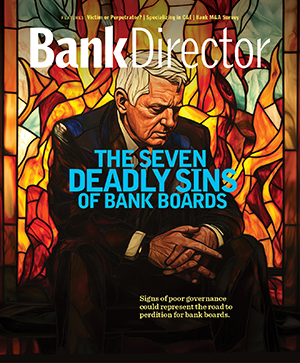
Do Pay-for-Performance Plans Work?
More institutions are adding a discretionary component when determining executive compensation to reward achievements that are difficult to measure.
Brought to you by Blanchard Consulting Group

During 2023 and early 2024 we had a number of conversations with clients that focused on how incentive plans were not likely to pay out at targeted levels. This was primarily due to banks not meeting their budgets and achieving results below the desired performance levels.
We decided to test this reality by using an internal database to analyze 177 CEO and 106 CFO positions from banks across the country. We examined cash incentive and bonus payments to determine if they decreased in 2023 compared to 2022 and 2021.
Findings on Cash Incentives/Bonuses for CEOs and CFOs
For both the CEO and CFO positions, the study found that the median value of cash incentive/bonus payouts decreased in 2023 compared to 2022 by approximately 18% for the CEOs and approximately 24% for the CFOs. The 2021 and 2022 cash incentives/bonuses were paid at very similar levels for the CFOs. The CEOs had a modest cash incentive/bonus increase from 2021 to 2022.
| CEOs (N = 177 Banks) | CFOs (N = 106 Banks) | |||||
| Year | 2023 | 2022 | 2021 | 2023 | 2022 | 2021 |
| Cash Incentive/Bonus Paid – 50th Percentile (Median) | $184,439 | $225,000 | $193,262 | $74,500 | $97,450 | $94,968 |
Source: Blanchard Consulting Group’s internal database, data from S&P Financial and the 2024 Blanchard Consulting Group’s Compensation Trends and Employee Benefits Survey.
ROAA and ROAE Findings
We also analyzed year-end return on average assests (ROAA) and return on average equity (ROAE) performance for each bank associated with the CEO and CFO analysis. Our research found that ROAA and ROAE performance correlated with the cash incentive/bonus data. The median 2023 ROAA for these banks decreased by approximately 17% compared to 2022 and 2021. Similar results were found with 2023 ROAE as compared to 2022. Approximately 70% of banks saw their ROAA and ROAE decrease from 2022 to 2023.
| CEO Banks (N = 177) | CFO Banks (N = 106) | |||||
| Year | 2023 | 2022 | 2021 | 2023 | 2022 | 2021 |
| ROAA – 50th Percentile (Median) | 0.91 | 1.10 | 1.13 | 0.92 | 1.12 | 1.17 |
| ROAE – 50th Percentile (Median) | 10.23 | 12.47 | 11.63 | 10.11 | 11.77 | 12.03 |
Source: Blanchard Consulting Group’s internal database, data from S&P Financial and the 2024 Blanchard Consulting Group’s Compensation Trends and Employee Benefits Survey.
Current Trends in Annual Incentive Plan Designs
Economic challenges have prompted adjustments in annual incentive plan designs, including:
1. Wider payout/goal ranges. Since predicting annual budgets is challenging in difficult economic times, many banks increased their payout/goal ranges in their annual incentive plan, especially at the lower end. Historically, banks set their threshold payout level — performance below budget where an incentive is still paid — at 90% to 95% of the budget. This typically results in approximately 50% of the target payout. Some banks have lowered this threshold performance level to 80% to 85% of the budget and have decreased the payout to approximately 25% of the target amount.
2. Use of strategic/department goals. Numerous banks now include strategic or department goals core deposit growth and credit quality — into their annual incentive plan design. These goals typically have a 10% to 25% weighting in the performance scorecard for executives. This allows the bank to provide a payout based on a goal linked to the long-term viability of the bank instead of having all goals based on profitability. This methodology is also considered a best practice in the Sound Incentive Compensation Guidelines released by the regulatory agencies in 2010 and most recently in section 956 of the Dodd-Frank Act, which was re-proposed in 2024.
3. Use of discretion. Banks have incorporated discretion into their annual cash incentive plan. The discretionary component is typically capped at 10% to 20% of the total incentive award. This payout can reward an executive or key officer for goals that are difficult to measure and is often linked to an individual’s performance evaluation. The board can also use discretion to reduce or eliminate an incentive if certain performance qualifiers are not met, such as satisfactory regulatory ratings, credit quality issues or unsatisfactory performance reviews.
Cash incentives remain prevalent in the banking industry, as the Blanchard Consulting Group 2024 Compensation Trends & Employee Benefits Survey showed that approximately 93% of banks paid cash incentives or bonuses for 2023 performance. Our analysis shows that a solid pay versus performance link exists with incentive plans in the banking industry as decreases in profitability and financial performance in 2023 resulted in lower cash incentives/bonuses for the CEO and CFO positions. This is a reminder that performance-based annual incentive plans aim to increase or decrease variable pay levels based on annual results.




